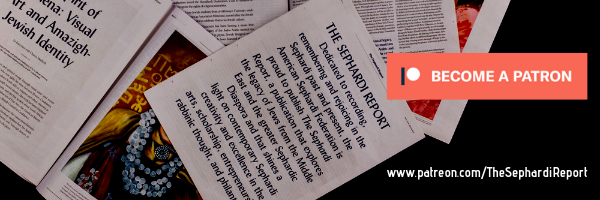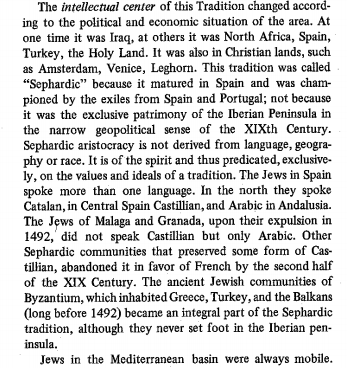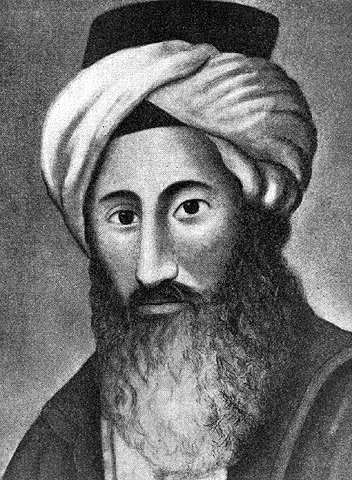Exclusive SIM Interview: Dr. Mijal Bitton on Hakham Professor R’José Faur, A”H

Mazal tov/Mabrouk to ASF Young Leaders Founder & President Lauren Gibli on her engagement!
Click here to dedicate a future issue in honor or memory of a loved one.

The Monthly Sage ◊ Feature ◊ Sephardi Gifts ◊ Upcoming Events ◊ Donate ◊ Archive
The Sephardi Ideas Monthly is made possible by generous readers like you. Become a Patron of the Sephardi Ideas Monthly via Patreon and your name will appear in each edition along with essays and interviews from the rich, multi-dimensional world of Sephardi thought. Thanking you in advance!

Sephardi Ideas Monthly is a continuing series of essays and interviews from the rich, multi-dimensional world of Sephardi thought that is delivered to your inbox every month.
This month’s issue of Sephardi Ideas Monthly concludes our three-part series dedicated to introducing the dizzyingly rich and varied thought of Hakham Professor R’José Faur. Our August issue featured Dr. Mijal Bitton’s extended essay, “The Torah of Hakham José Faur,” while last month we introduced R’Faur’s learned, acerbic, fascinating, and polemical defense of Maimonidean humanism, “Anti-Maimonidean Demons” (Review of Rabbinic Judaism 6, 2003).
With our October issue, we conclude with an original interview with Dr. Bitton, a Fellow in Residence at the Shalom Hartman Institute of North America and the communal leader and co-founder of the Downtown Minyan in New York City. Bitton was named an American Sephardi Federation Broome & Allen Fellow in 2018 and was selected the same year for inclusion in the New York Jewish Week‘s “36 under 36.” Aside from earning her doctorate from New York University, Bitton also happens to be R’Faur’s great-niece. The interview was conducted via email, with Bitton kindly taking time out from her work and family during this very challenging time to answer our questions.
Dr. Mijal Bitton’s Interview with SIM

Sephardi Ideas Monthly (SIM): In your article, “The Torah of Hakham José Faur,” you write that Faur’s “rigorous intellectual tradition” didn’t align with “the current trend of identity politics, where to be Sephardic is mainly an identity…” How then would you describe the character of his “contrarian” intellectual tradition? What were its main elements?
Mijal Bitton (MB): There were many aspects to Hakham Faur’s Rabbinic intellectual tradition. One of the important aspects central to his thinking was a focus on methodology. For Hakham Faur, it was not enough to have information, one needed to acquire wisdom in a systematic way and follow consistent and coherent rules for the application of knowledge. This is critical to Hakham Faur’s philosophy and means two things: (i) memorizing data, or citing statements said by others, are not the most advanced approach in Rabbinic discourse, and (ii) it is not enough to be smart: the caliber of a Jewish sage is built first and foremost upon allegiance to an intellectual tradition and command of its methodology. This approach was different from many of the non-Maimonidean streams in the Jewish tradition, according to which one can demonstrate that something is forbidden or permitted by citing some prominent names whose statements have been memorized, without explaining the statements themselves. So, for instance, for Hakham Faur Maimonides was a giant of the Rabbinic world not because of his IQ, but because he was methodical in his approach and an effective proponent of Rabbinic tradition. So, too, students of Hakham Faur would not believe it is enough to quote Maimonides and cite his authority. Rather, they are tasked with following Maimonides’s carefully laid out journey through the sources and understanding his conclusions.
SIM: What particular aspects of Maimonides’ Torah, broadly understood, did Faur take up and wish to advance?
MB: I loved learning about my great-uncle’s time at Lakewood and I also know there’s so much I still need to learn about those special years! I think his time in Lakewood gave my great-uncle deep internal knowledge of Orthodox jurisprudence, learning and theology. There were many things he shared with that world − perhaps above all his total dedication to, and love for, Talmud Torah. But being in Lakewood also strengthened his own commitments in contrast to theirs. Ironically, I learned from one of my great-uncle’s students that the German-Jewish family that hosted him during these years had brought a large secular library with them from Europe, and it was there that he studied 19th and 20th century Western intellectual works, all in the original German and French.
SIM: Hakham Faur was a traditional Jew committed to rearticulating the meaning of “Old Sepharad.” He was also an incredibly open thinker who, as you noted in your article, deeply engaged the linguistic theories of post-modern thinkers. How did these two worlds fit together in Faur’s world?
MB: The key to understanding Hakham Faur’s philosophy is in approaching God as a writer. Once God is a writer, then anything that God created – be it people, nature, galaxies or the Torah itself — is a text that we are supposed to read. Hakham Faur’s genius was in utilizing the tools and techniques of the academic study of semiotics to generate new ways of approaching the Torah and the world as a “text” meant to be read by us. But I wouldn’t classify my great-uncle as being totally immersed in post-modern linguistic theory. He did not make use of scholars like, say, Michel Foucalt, who sought to deconstruct discourse in search of genealogies and power dynamics. I would hazard to say that Foucalt’s school of discourse analysis − one that is deeply skeptical about our capacity to achieve objective truth − does not fit the deep demand for methodology and shared understanding in a community of readers that Hakham Faur believed in.
SIM: Does Hakham Faur’s writings have anything in particular to say to young Jewish women?
MB: Hakham Faur’s writings have what to say to anyone – to all people at all stages of their lives. He would resist, I believe, an emphasis on identity as a precondition for understanding. I do think that Hakham Faur’s work presents both a challenge and an opportunity for young women. It challenges young Jewish women since his work demands intimate, first-hand knowledge and expertise in the rabbinic tradition (he prized reading the Tanakh with proper Dikduk (grammar) and cantillations, and memorizing Mishna) and many young women have not received the training to have this type of knowledge. But Hakham Faur’s work also presents an opportunity because knowledge is not gendered − in other words, any barriers for entry could (under the right conditions) be overcome by anyone who wants to learn Torah.
SIM: A young, intellectually-spiritually adventurous young Jew, with a desire to explore Hakham Faur’s writings, approaches you, wondering where to begin. What do you answer?
MB: I would suggest they start with The Horizontal Society. In this book, Hakham Faur clearly and systematically presents conclusions from his previous works which can be a bit harder to read and are more appropriate for more advanced students of his work.
Feature: Hakham Professor R’José Faur on Sephardi Terminology

Writing in the inaugural issue of The Sephardic World (Vol. 1 No. 1, Summer 5732/1972), Hakham Professor R’José Faur describes the development of the multi-national and mobile but intellectually rooted Sephardic Jewish community, even for those whose ancestors “never set foot in the Iberian peninsula.” Indeed, “Sephardic aristocracy is not derived from language, geography or race. It is of the spirit and thus predicated, exclusively, on the values and ideals of a tradition.”
~~~~~~~


The featured sage for the month of October is Haim Yosef David Azoulai, popularly known as the HID”A (1727-1806).
Born in Hevron to parents who made Aliyah to the Land of Israel from Europe and Persia, little Haim Yosef appeared to have passed away, only for his grandmother to recognize that the seven-month old baby was still breathing.
As a young man Haim Yosef learned Torah with the sages of Jerusalem, until he began to serve as an emissary to Jewish communities throughout North Africa and Western Europe. Hakham Haim Yosef made three separate trips in 1755, 1770, and 1781, and he collected original manuscripts wherever he went, amassing a large library. He ultimately settled in Livorno, Italy, at the request of the community. In Livorno, the HID”A dedicated much of his time to writing, until his passing in 1806. In 1960 his remains were brought to Jerusalem for burial.
The HID”A authored over eighty books, including Biblical and Talmudic commentaries, works on Halakha, and sermons. He also composed history books and fascinating reports from his journeys. Thanks to his European and Central Asian familial roots as well as his travels throughout the Mediterranean, the HID”A developed a pluralistic appreciation for the distinctive characteristics of various Jewish cultures that emerged in different locales.
In the following passage, the HID”A writes that no vowel symbols appear in the Torah so that words can be read in various ways, and different interpretations can be proposed for the meaning of the Biblical text:
The Torah scroll has no vowel symbols (nikkud) so that people may interpret as they wish. The letters, not being marked with vowels, tolerate different meanings, and can break up into many sparks. This is why we were instructed not to punctuate Torah scrolls with vowels. For it is the vowel punctuation that gives each word its meaning, and a word with vowel punctuation has but a single meaning, while without vowels a person may understand many worthy and wondrous things. Understand this, for you will find it necessary on many occasions…
Upcoming Events or Opportunities:
 Announcing ChaiFlicks, the American Sephardi Federation’s Official Streaming Service. Announcing ChaiFlicks, the American Sephardi Federation’s Official Streaming Service.Featuring the Best in Jewish Entertainment, including your favorite films from the New York Sephardic Jewish Film Festival! Sign-up Now! |
| The ASF Institute of Jewish Experience presents: New Works Wednesdays November Program:  Wednesday, 4 November at 12:00PM EST Shalva Weil discusses her new book, “The Baghdadi Jews in India: Maintaining Communities, Negotiating Identities and Creating Super-Diversity.” Sign-up Now!  Wednesday, 11 November at 12:00PM EST Stanley Mirvis discusses his new book, “The Jews of Eighteenth-Century Jamaica: A Testamentary History of a Diaspora in Transition.” An in-depth look at the Portuguese Jews of Jamaica and their connections to broader European and Atlantic trade networks. Sign-up Now!  Wednesday, 18 November at 12:00PM EST Jane Gerber discusses her new book, “Cities of Splendour in the Shaping of Sephardi History.” Sign-up Now!  Wednesday, 25 November at 12:00PM EST Cedric Cohen-Skalli discusses his new book, “Don Isaac Abravanel: An Intellectual Biography.” Sign-up Now! Sponsorship opportunities available: info@americansephardi.org |
| The ASF Institute of Jewish Experience presents: At the Crossroads of Sephardic, Mizrahi, and Russian-Speaking Worlds: The History of Bukharian Jews (2-Part Series) The culture and history of Bukharian Jews is situated at the unique, intersection of Sephardic, Mizrahi and Russian-speaking Jewish identities. Through this 2-part learning series, we will explore the multilayered, rich story of this millennia-old community—discovering the ways in which they have developed their mosaic culture through a dynamic interaction with the dominant and changing societies surrounding them. Our discussion will also shed light on how their experiences fit into the broader historical saga of the Jewish people. Thursdays 12 and 19 November at 12:00PM EST Sign-up Now!  Born in Uzbekistan, raised in Seattle, and currently based in New York City, Ruben Shimonov is a Jewish educator, community builder, social entrepreneur and artist with a passion for Jewish diversity and pluralism. He previously served as Director of Community Engagement & Education at Queens College Hillel—where he had, within his vast portfolio, the unique role of cultivating Sephardic & Mizrahi student life on campus. Currently, he is the Founding Executive Director of the Sephardic Mizrahi Q Network—a grassroots movement building a supportive, vibrant and much-needed community for LGBTQ+ Sephardic & Mizrahi Jews. He also serves as Vice-President of Education & Community Engagement on the Young Leadership Board of the American Sephardi Federation, as well as Director of Educational Experiences & Programming for the Muslim-Jewish Solidarity Committee. Within both organizations, Ruben has used his artistry in Arabic, Hebrew & Persian calligraphy to enhance Muslim-Jewish dialogue and relationship building. In 2018, Ruben was listed among The Jewish Week’s “36 Under 36” young Jewish community leaders and changemakers. He has lectured extensively on the histories and cultures of various Sephardic & Mizrahi communities. Among his speaking engagements, he has been invited to present at Limmud Seattle, NY and U.K. He is also an alumnus of the COJECO Blueprint and Nahum Goldmann Fellowships for his work in Jewish social innovation. Sponsorship opportunities available: info@americansephardi.org |
| The ASF Institute of Jewish Experience presents: New Works Wednesdays December Program:  Wednesday, 2 December at 12:00PM EST Danny Bar Maoz discusses his new book, “Life without a Childhood in the Yemenite Jewish Community 1882-1948.” The book is in Hebrew (חיים ללא ילדות בקהילות יהודי תימן 1882-1948) but the lecture will be given in English. Sign-up Now!  Wednesday, 9 December at 12:00PM EST Aviva Ben-Ur discusses her new book, “Jewish Autonomy in a Slave Society: Suriname in the Atlantic World, 1651-1825.” Sign-up Now! Sponsorship opportunities available: info@americansephardi.org |
 The ASF Institute of Jewish Experience presents: The Greek Experience Explore the world of Greek Jewry from the ancient Romaniote to the Sephardim and others who made it to and through Greece. An online course presented in 10 minute episodes. Learn at your own pace. Please sign-up now! Total cost of the course is $75.00 Jews have been in Greece since before the Temple was destroyed. They were in Greece upon the founding of the Greek Orthodox Church. Community members, known as Romaniote, made their way through Venice, Byzantium, Spain, across the Ottoman Empire, and beyond. Dr. Yitzchak Kerem provides an overview of the unique languages, liturgical nuances, and communal life of Jews across Greece. Dr Kerem spent significant time living in Greece and researching Greek and Sephardic history. Photographs, maps, and personal accounts provide course participants with a full picture of the unique nature of the Jews of Greece and its surroundings. In the course, participants will look at major influential points in Greek Jewish history. They will explore The Golden Age of Salonika, a time when Greece’s northern city was a hub of Jewish scholarship. Kerem introduces the tension arising in the Greek Jewish community because of Shabtai Tzvi and the Sabbateanism movement that brought with it false messianism and conversion to Islam, at least outwardly. The course looks at when the Alliance Israélite Universelle moved in and the Sephardic culture in Greece developed a rich secular culture with its own novels, theater, and music. This is part of the greater Jewish heritage and history that is often overlooked. ASF IJE online courses will bring to life all parts of the greater Jewish Experience. For more information and other ASF IJE online course offerings visit: https://courses.instituteofjewishexperience.org/ |
 The ASF Institute of Jewish Experience presents: The Crypto Experience The Global History of Secret Jews An online course presented in 10 minute episodes. Learn at your own pace. Please sign-up now! Total cost of the course is $75.00 The ASF Institute of Jewish Experience is proud to present “The Crypto Experience,” an online course on Crypto-Jews. It is part of a series of online courses on a variety of topics that make up the robust Jewish experience. For hundreds of years there have been descendants of Crpto-Jews, who have covertly kept some of their traditions while maintaining a very different public persona. It is a question of identity, be it Huegenot, Catholic, Sephardi, or Mashadi. Professing one faith on the outside and another on the inside speaks to our quest for defining identity today. These questions of identity that we think are so new and so relevant are really rather old questions under different circumstances. In this course Dr. Hilda Nissimi (Bar Ilan University) presents an overview of crypto societies historically and in the context of today. She challenges the participants to ask themselves difficult questions like: What defines identity? If I project this outer self, how do I keep my real me? Who is the real me? Am I the me before the expression of an outer facade? Is it a new me? The course discusses these questions as they pertain to Jews, specifically. What does it mean to be a Jew? What do I have to keep if I want to call myself a Jew? Am I allowed to change? Am I the person to decide? Who will decide? How can anyone decide under such circumstances? In order to understand this in historic and cultural contexts, world-renowned scholars and experts in the field have joined Dr. Nissimi and will be presenting the challenges facing a range of crypto societies: Huegenots – Dr. Hilda Nissimi Spanish-Portuguese Crypto Society – Dr. Ronnie Perelis (Yeshiva University) Bildi’in of Morocco – Professor Paul Fenton (Sorbonne Université, Paris) Mashhadi Jews of Iran – Dr. Hilda Nissimi Tracing Jewish Roots – Genie and Michael Milgrom Growing Up Mashhadi– Reuben Ebrahimoff For more information and other ASF IJE online course offerings visit: https://courses.instituteofjewishexperience.org/ |
Donate now All Jews Together @ the ASF’s Institute of Jewish Experience“We have to unite our energies together. All Jews, together…. If we are united, all Sephardim and also Ashkenazim, together… we will see the light!” ~Enrico Macias The ASF Institute of Jewish Experience is uniquely dedicated to ensuring that today’s Jews know our history; appreciate the beauty, depth, diversity, and vitality of the Jewish experience; and have a sense of pride in Jewish contributions to civilization. |